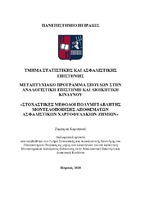| dc.contributor.advisor | Χατζηκωνσταντινίδης, Ευστάθιος | |
| dc.contributor.author | Καρυτινού, Ζαφειρία | |
| dc.date.accessioned | 2021-01-14T08:23:38Z | |
| dc.date.available | 2021-01-14T08:23:38Z | |
| dc.date.issued | 2020 | |
| dc.identifier.uri | https://dione.lib.unipi.gr/xmlui/handle/unipi/13168 | |
| dc.identifier.uri | http://dx.doi.org/10.26267/unipi_dione/591 | |
| dc.description.abstract | Η εργασία αυτή επικεντρώνεται στην ανάδειξη των μοντέλων που χρησιμοποιούνται για την εύρεση των αποθεμάτων ασφαλιστικών χαρτοφυλακίων και συγκεκριμένα για χαρτοφυλάκια γενικών ασφαλίσεων. Ο στόχος της εργασίας είναι η παρουσίαση των μεθόδων αυτών στους αναγνώστες με τρόπο εύκολο και κατανοητό. Η μέθοδος που θα μελετηθεί είναι η μέθοδος της τριγωνικής εξέλιξης ζημιών ή όπως είναι γνωστή στη βιβλιογραφία ως Chain – Ladder Method.
Η Chain – Ladder Method (CL) είναι μια από τις πιο διαδεδομένες μεθόδους που χρησιμοποιούνται για να εκτιμηθούν τα αποθέματα ασφαλιστικών χαρτοφυλακίων. Λόγω όμως ότι η μέθοδος αυτή επηρεάζεται αρκετά από ακραίες παρατηρούμενες τιμές (όπως για παράδειγμα ένα πολύνεκρο ατύχημα, ένας καταστροφικός σεισμός ή έντονα καιρικά φυσικά φαινόμενα που μπορεί να προκαλέσουν καταστροφικές ζημίες) είναι γεγονός ότι οι αναλογιστές προτιμούν να διασπούν το ασφαλιστικό χαρτοφυλάκιο σε άλλα μικρότερα χαρτοφυλάκια συνήθως ανάλογα με τις επιχειρησιακές γραμμές που έχει η εταιρία ούτως ώστε να γίνει μια πιο λεπτομερή και στοχευόμενη εκτίμηση των αποθεμάτων που πρέπει να κρατούνται.
Αυτομάτως, η μέθοδος της Chain – Ladder μετατρέπεται σε Πολυμεταβλητή Chain – Ladder καθώς πλέον εργαζόμαστε σε μικρότερα ομοιογενή χαρτοφυλάκια από τα οποία το τελικό αποτέλεσμα της εκτίμησης θα προκύψει αν προσθέσουμε τις εκτιμήσεις του κάθε υπό-χαρτοφυλακίου. Η μοντελοποίηση αυτή και οι εκτιμήσεις των μελλοντικών υποχρεώσεων είναι από τις σημαντικότερες εργασίες που πρέπει να γίνονται σε μια ασφαλιστική εταιρία. Βάσει νόμου, η ασφαλιστική εταιρία θα πρέπει να δημιουργεί τα αποθέματά της με αυτό τον τρόπο ώστε να είναι φερέγγυα.
Τέλος, η μέθοδος αποθεματοποίησης Πολυμεταβλητής Chain – Ladder είναι η πιο διαδεδομένη και εύκολης χρήσης μέθοδος που χρησιμοποιείται ακόμα και στις μέρες μας από τους αναλογιστές. Μέσα στην παρούσα διπλωματική εργασία θα υπάρξει και αναλυτικό παράδειγμα για το πώς εφαρμόζεται και χρησιμοποιείται η μέθοδος αυτή. | el |
| dc.format.extent | 130 | el |
| dc.language.iso | el | el |
| dc.publisher | Πανεπιστήμιο Πειραιώς | el |
| dc.rights | Attribution-NonCommercial-NoDerivatives 4.0 Διεθνές | * |
| dc.rights | Attribution-NonCommercial-NoDerivatives 4.0 Διεθνές | * |
| dc.rights.uri | http://creativecommons.org/licenses/by-nc-nd/4.0/ | * |
| dc.title | Στοχαστικές μέθοδοι πολυμεταβλητής μοντελοποίησης αποθεμάτων ασφαλιστικών χαρτοφυλακίων ζημιών | el |
| dc.type | Master Thesis | el |
| dc.contributor.department | Σχολή Χρηματοοικονομικής και Στατιστικής. Τμήμα Στατιστικής και Ασφαλιστικής Επιστήμης | el |
| dc.description.abstractEN | The purpose of this paper is to examine the use of the Loss Reserving Methods and especially the use of a Multivariate version of the Chain – Ladder Method in the insurance companies. The aim is to introduce the readers the method in a simple and intuitive way.
Based on Solvency II each insurance company is obliged to count and keep a capital adequacy for the possible claims that the insured clients will demand. Hence, it is very important for the company to count the reserves that must keep so as being solvent. The Multivariate Chain – Ladder method is one of the Loss Reserving Methods that counts the reserves the company must have.
The Multivariate Chain – Ladder Method is based on a stochastic model such as the Chain – Ladder. It is the multivariate version of Schnaus model and extends the univariate model of Mack. It is preferred when the insurance portfolio consists several subportfolios with a certain dependence structure and it resolves in a way the problem of non- additivity of the univariate chain – ladder method.
The chain – ladder method is the most famous method and it is widely used from the actuaries. This method applies in a single run – off triangle and it is well – known that the chain ladder’s predictors for the non – observable (future) total claims of a total portfolio consisting of several subportfolios differ, from the sums of the chain – ladder predictors for the non – observable total claims of the subportfolio.
Finally, in this paper I will describe the data that we need for using run – off triangle techniques. Moreover, I will introduce the concept behind the mathematical techniques and I will demonstrate how run – off triangles are constructed for both incremental and cumulative claims loss amounts. | el |
| dc.contributor.master | Αναλογιστική Επιστήμη και Διοικητική Κινδύνου | el |
| dc.subject.keyword | Αποθέματα | el |
| dc.subject.keyword | Bornhuetter - Ferguson Method | el |
| dc.subject.keyword | Chain - Ladder Method | el |
| dc.subject.keyword | IBNR | el |
| dc.subject.keyword | Απόθεμα τριγώνων | el |
| dc.date.defense | 2020-09-22 | |



